All products featured are independently chosen by us. However, SoundGuys may receive a commission on orders placed through its retail links. See our ethics statement.
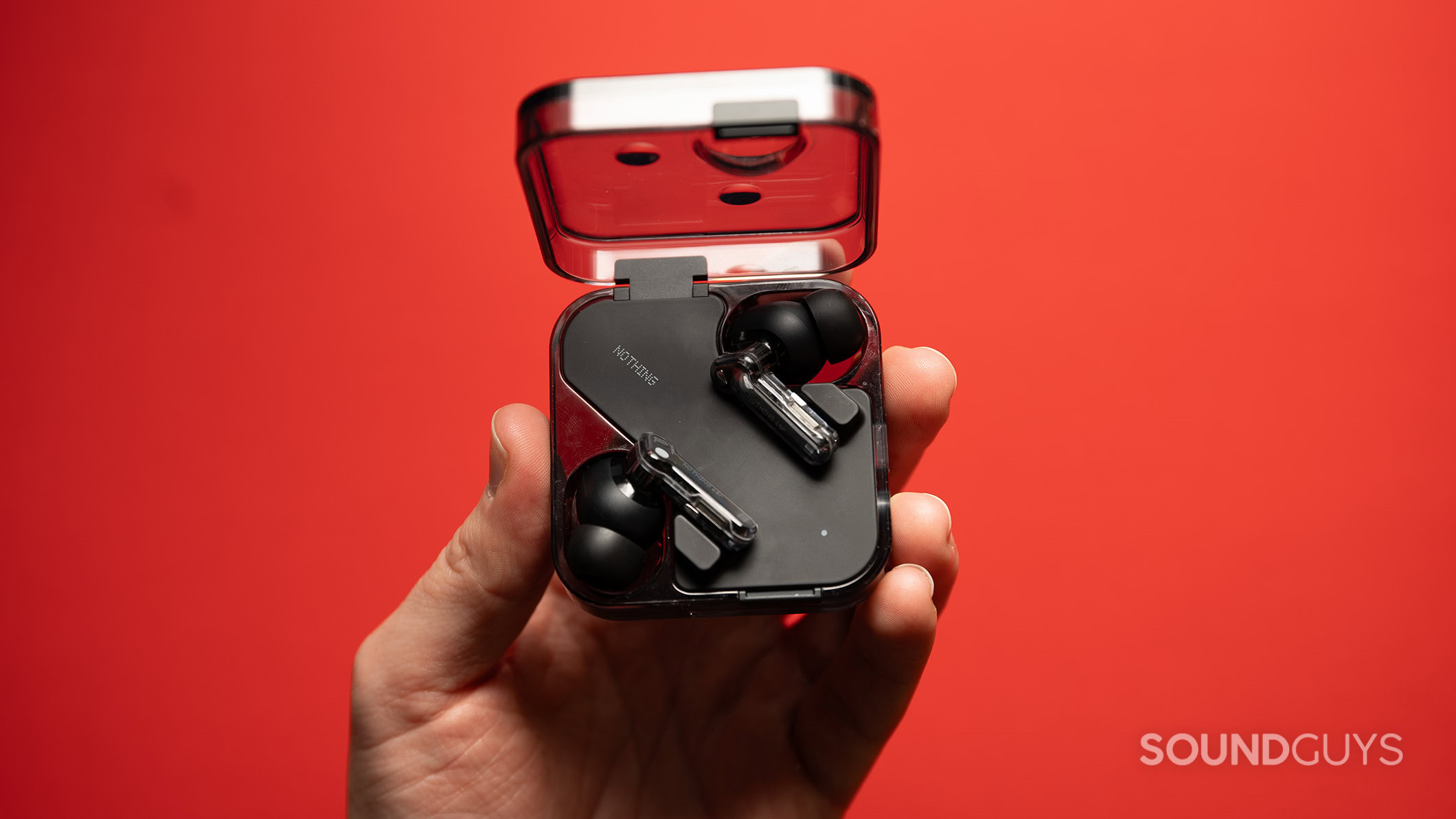

Nothing Ear review
Published onNovember 18, 2024


Nothing Ear
Nothing first released the Nothing Ear 1, then the Nothing Ear 2, so logically, that means the next generation should be called the… uh — checks notes — Nothing Ear?
Ridiculous naming aside, let’s take a deep dive in this Nothing Ear review to see if these earbuds are a worthy upgrade from previous generations.
Editor’s note: this article was updated on November 18, 2024, to include information about ChatGPT integration with the Nothing Ear.
The Nothing Ear are an excellent option for anyone seeking feature-packed earbuds that deliver premium performance at a lower price than the flagship options from Apple, Samsung, Sony, and Bose.
What’s it like to use the Nothing Ear?
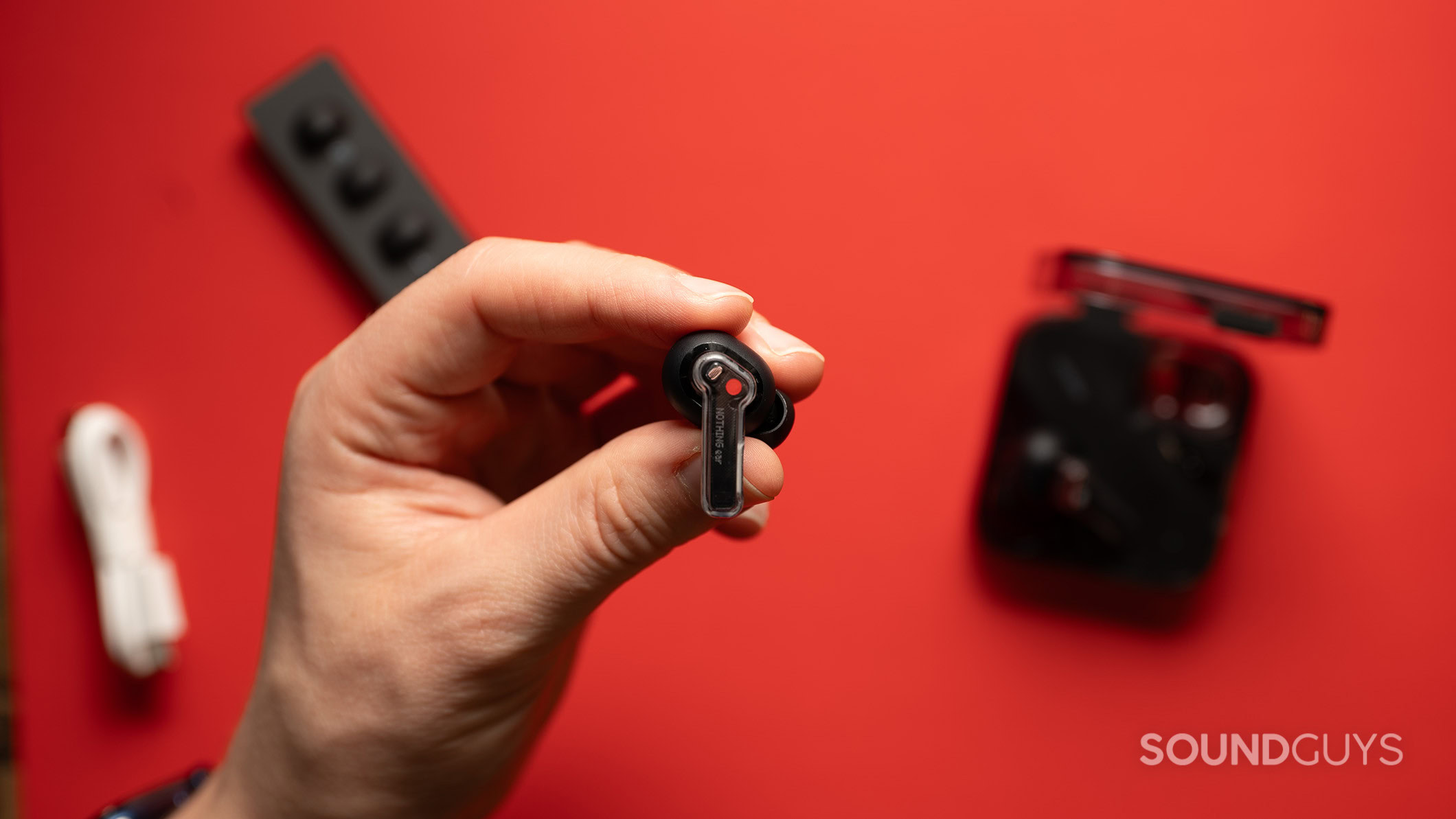
Nothing has retained the same form factor as the prior generations of the Ear. I’m not complaining, though — it continues to be one of my favorite wireless earbud designs on the market. At 4.6g each, the earbuds are lightweight and comfortable for hours. The charging case is portable, and the transparent design of the whole package is as eye-catching as ever (although the black color option is a fingerprint magnet).
Most people wear wireless earbuds outside the house, so it’s great that the earbuds and charging case of the Nothing Ear are dust and water-resistant. The earbuds have an IP54 rating, whereas the case has an IP55 rating. Whether it’s a beach day or a rainy day, you can bring the Nothing Ear with you.
How do you control the Nothing Ear?
The stem protruding from each earbud features a pressure-sensitive panel for pinch controls. Once you know where to squeeze, it’s a pretty intuitive control system. I prefer it to the tap controls found on other earbuds since using those often can compromise the fit and seal of the earbuds inside your ear. Squeezing the stem doesn’t disrupt the fit of the ear tips in the ears at all. You can customize the controls within the Nothing X app, though we’ve outlined the default controls for you here. Notably, the left and right earbuds are set to the same controls by default, which makes these controls easy to learn.
| Left earbud | Right earbud | |
|---|---|---|
Single pinch | Left earbud Play/pause, answer/end call | Right earbud Play/pause, answer/end call |
Double pinch | Left earbud Skip forward, decline call | Right earbud Skip forward, decline call |
Triple pinch | Left earbud Skip back | Right earbud Skip back |
Pinch and hold | Left earbud Noise control | Right earbud Noise control |
Should you use the Nothing X app for the Nothing Ear?
The Nothing X app has a few unique offerings that accommodate both audio enthusiasts and those with little knowledge of sound. Let’s start with the equalizer, where you can choose from either a basic or advanced graphic equalizer. The basic EQ is ideal if you want to crank up the bass, mids, or treble. This is also where you’ll find the personal sound profile feature, which conducts a hearing test to determine how well you can hear high frequencies and adjust the sound accordingly. Nothing partnered with Mimi Hearing for this feature, a company that produces a hearing test app certified for medical devices. I preferred the earbuds’ sound with the personal sound profile enabled, which isn’t always the case with these kinds of features.
You should jump straight into the advanced equalizer if you are an audiophile. This is a true parametric equalizer, with the option to dial in the Q of the filter at the exact frequencies of your choosing. The advanced equalizer is also now available with the Nothing Ear (2) but is not with the Nothing Ear (a). You can also pair the new Bass Enhance functionality with your equalizer settings, which dynamically analyzes and boosts low frequencies in real-time, providing a different experience to a classic equalizer that boosts the selected frequencies all the time. There are five levels to Bass Enhance, with level 5 providing a massive boost to the low end.
The Nothing Ear have ChatGPT integration, though you need a supported Nothing phone in order to use the feature. Once enabled, you can access ChatGPT directly through the pinch controls. We found the feature more hype than help in our experience using ChatGPT with the Nothing Ear.
Our firmware update took 3 minutes and 30 seconds, which is nice and speedy.
How do the Nothing Ear connect?
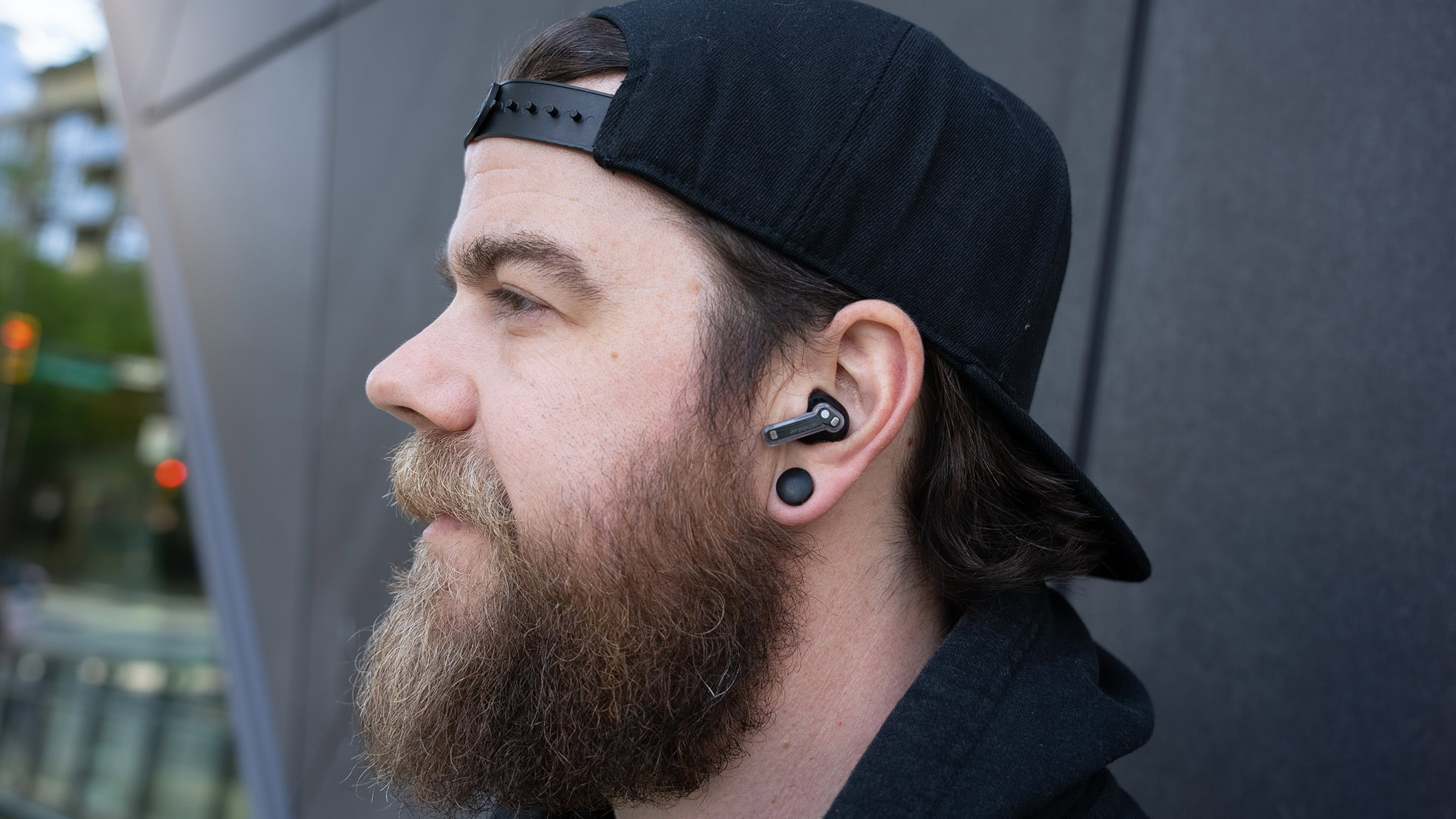
The Nothing Ear use Bluetooth 5.3 to connect to devices, which future proofs it to upcoming technologies such as Auracast. The earbuds support a few high-quality Bluetooth codecs, including LHDC 5.0 and LDAC. LHDC delivers the highest streaming quality at up to 1Mbps 24 bit/192kHz, whereas LDAC has a slightly lower data rate of up to 990 kbps 24 bit/96kHz but is supported on more devices. That said, if you have an iPhone, you won’t be able to take advantage of these features. Apple devices, as well as most Android devices, still connect to Bluetooth using AAC or SBC.
We experienced connection drops when connected to an iPhone and walking around busy downtown streets with sources of Bluetooth interference. Everywhere else, the Nothing Ear work fine. A few other Bluetooth features include Bluetooth multipoint, which connects to multiple devices simultaneously, and a low-latency gaming mode.
The Nothing Ear supports Microsoft Swift Pair and Google Fast Pair for instant pairing with supported devices. If the earbuds don’t automatically show up on your device, you can manually pair them. You’ll find a small round button next to the USB-C port on the charging case. Place the earbuds inside the charging case and press and hold the button to activate pairing mode. The Nothing Ear will then pop up in the Bluetooth settings on your device.
How long does the Nothing Ear battery last?
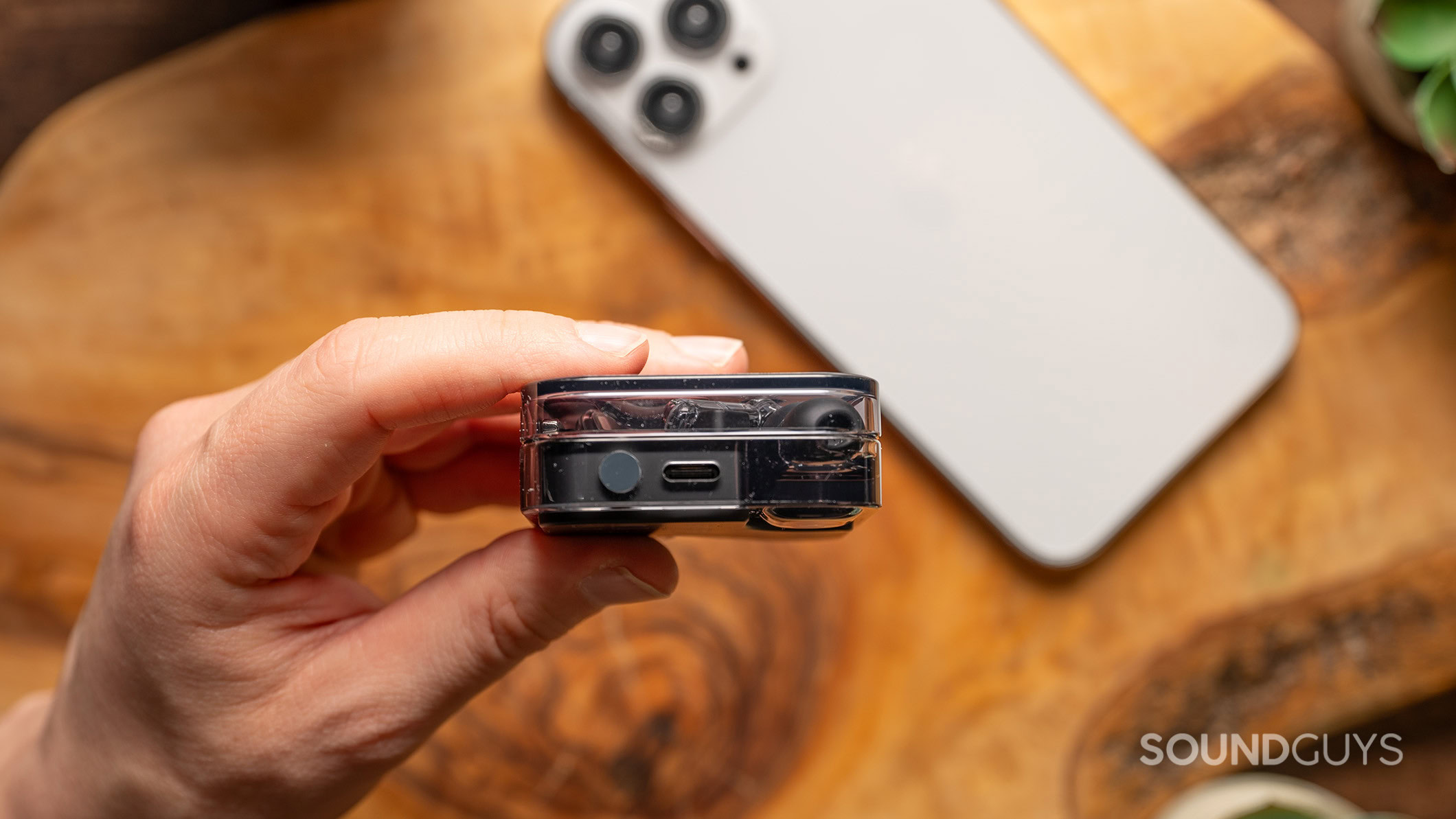
In our battery test, the Nothing Ear lasted 8 hours and 4 minutes. This is good for wireless earbuds and two hours longer than the Nothing Ear (2). The charging case provides a few extra charges, with Nothing claiming it’s possible to get up to 40 hours of total playback time.
The charging case supports wireless charging at up to 2.5W. For faster charging, you can power up the case over USB-C, which Nothing says can get you 10 hours of listening time from only 10 minutes.
How well do the Nothing Ear cancel noise?
Loading chart ...
While Nothing promises 45dB of noise attenuation extending up to 5kHz, we aren’t seeing those results in our testing lab. Our testing shows about 20dB of attenuation from the ANC in the low frequencies and then about 30dB of total attenuation in the high frequencies from passive isolation. This reduces the loudness of most sounds by around 75%. While this isn’t as good as the best noise canceling earbuds, it’s still pretty good.
A Smart ANC algorithm checks for noise leakage between the earbuds and ear canal each time you put them in. It then adjusts the level of noise canceling accordingly. You can also use the Adaptive ANC mode, which dynamically adjusts the strength of ANC depending on the environmental noise level around you. I never see a reason not just to leave ANC set to high, but to each their own.
The transparency mode is excellent at letting in outside noise in a natural-sounding way. Things still don’t sound quite as loud as they do without earbuds, but it’s close. Notably, the transparency mode is good enough for hearing traffic or holding a quick conversation without taking the earbuds off.
When you activate the transparency mode, the earbuds play the sound of a woman whispering into your ear. It’s…strange, but ASMR fans will enjoy it.
How do the Nothing Ear sound?
I’m very impressed by the sound quality of the Nothing Ear. After a bit of tinkering in the app, these are some of my favorite-sounding earbuds.
Multi-Dimensional Audio Quality Scores (MDAQS)
The chart below shows how the sound of the Nothing Ear was assessed by the Multi-Dimensional Audio Quality Score (MDAQS) algorithm from HEAD acoustics.
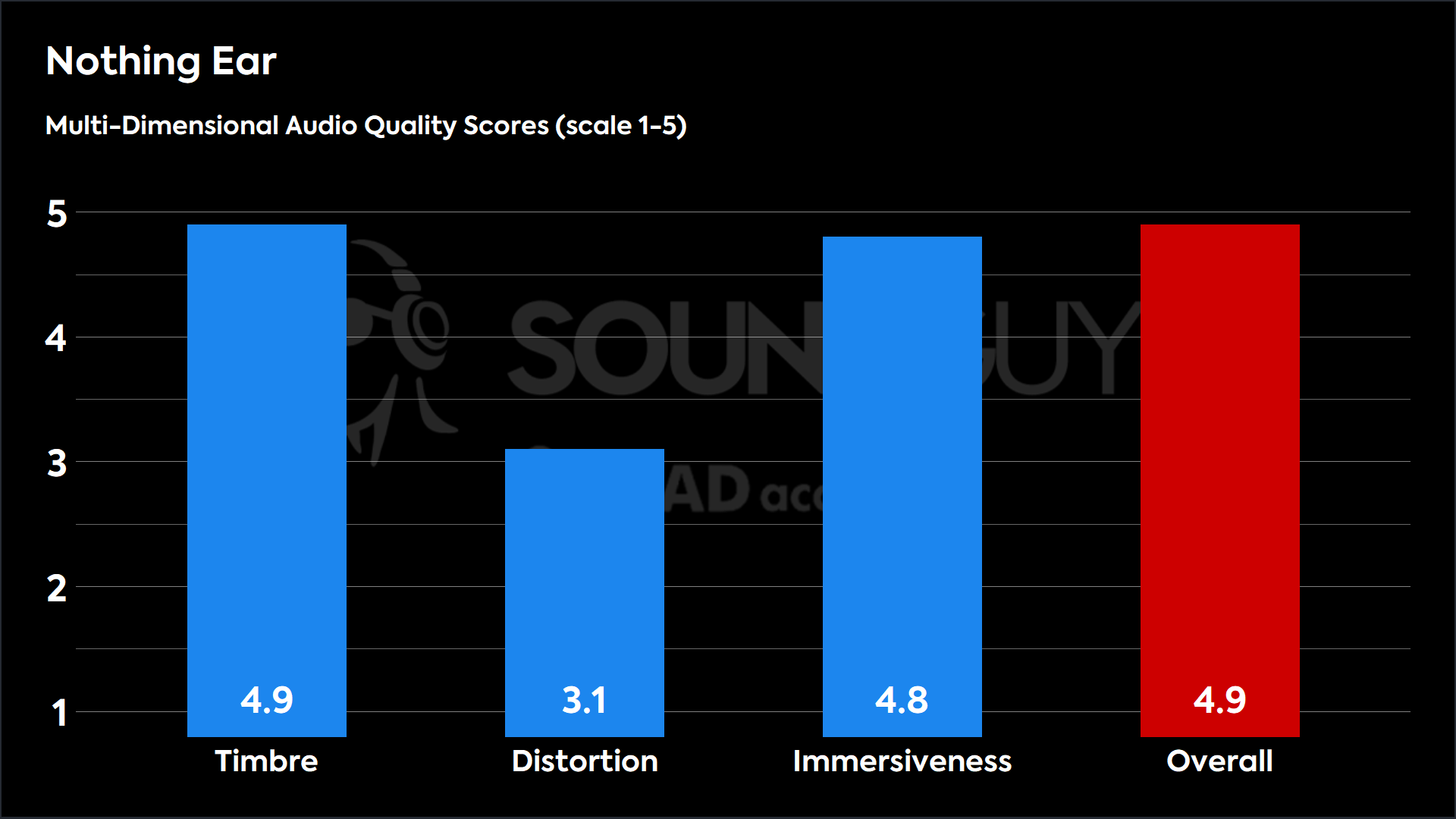
A simulated panel of listeners rates the Nothing Ear very highly in Timbre and Immersiveness. An Overall score of 4.9 is among the highest of the earbuds we’ve tested. Most people will like the way the Nothing Ear sounds straight out of the box.
Timbre (MOS-T) represents how faithfully the earbuds reproduce the frequency spectrum and temporal resolution (timing information).
Distortion (MOS-D) represents non-linearities and added noise: higher scores mean cleaner reproduction.
Immersiveness (MOS-I) represents perceived source width and positioning: how well virtual sound sources are defined in three-dimensional space.
See here for an explanation of MDAQS, how it works, and how it was developed.
Reviewer’s notes
Editor’s note: this review uses a hover-enabled glossary to describe sound quality based on a consensus vocabulary. You can read about it here.
Objective Measurements
Loading chart ...
As you can see in the chart above, the Nothing Ear has a default frequency response that amplifies low frequencies above our headphone preference curve. There is also a drop in output around 470Hz and a boost around 5.5kHz compared to our preference. You can easily equalize these variances using the advanced equalizer.
Loading chart ...
The Nothing Ear has exceptionally low measured harmonic distortion, a testament to the quality of the ceramic diaphragm drivers.
Bass Enhance Level 1
Loading chart ...
Level 1 of the Bass Enhance tames the bass frequencies more than the default frequency response, which employs enhancement level 3.
Bass Enhance Level 5
Loading chart ...
Level 5 of Bass Enhance significantly boosts low frequencies, especially in the sub-bass. This provides an intense listening experience with tracks with significant sub-bass, such as rap music featuring heavy bass and 808s.
Loading chart ...
Turning ANC off changes the response, reducing the bass emphasis. Keep that in mind when setting up your EQ settings.
Can you use the Nothing Ear for phone calls?
The Nothing Ear has three mics and an AI noise reduction algorithm to suppress background noise. While voices sound slightly muffled, the background noise reduction algorithm is one of the best we’ve heard. No matter where you are, the person on the other end of the line should still be able to understand what you are saying, which is reassuring.
Nothing Ear microphone demo (Ideal conditions):
How does the microphone sound to you?
Nothing Ear microphone demo (Office conditions):
Nothing Ear microphone demo (Street conditions):
Nothing Ear microphone demo (Windy conditions):
Nothing Ear microphone demo (Reverberant space):
The Nothing Ear mic system performs great in these simulated noise environments. In the simulated street environment, you can barely tell that there is any noise in the background. The microphones also handle wind noise better than most earbuds.
Should you buy the Nothing Ear?
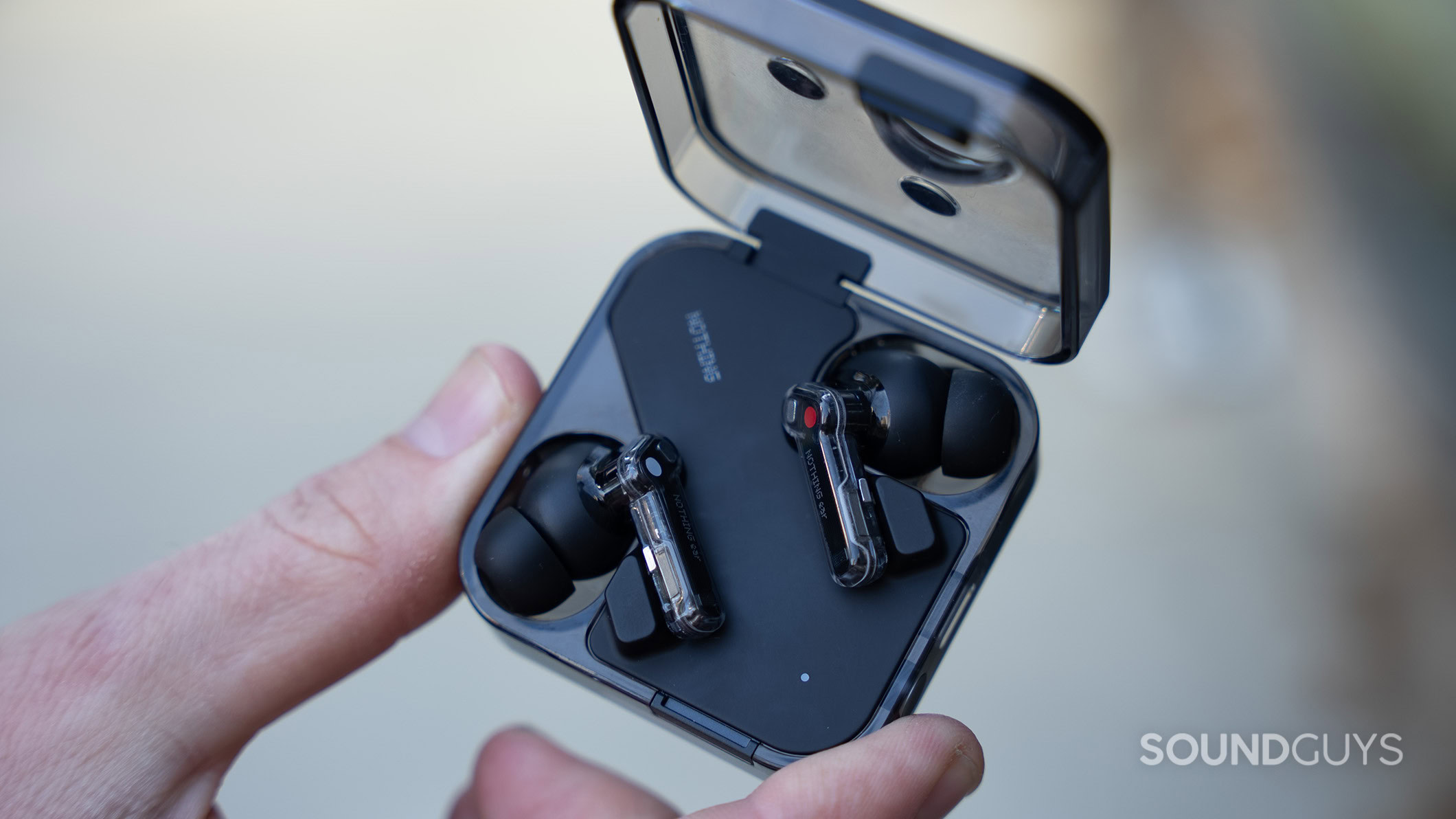
I would recommend the Nothing Ear to pretty much everyone. Casual listeners will appreciate the excellent design, noise canceling, and battery life. Serious listeners will enjoy the plethora of sound customization options, LHDC and LDAC support, and excellent sound clarity.
The fact that you can buy these earbuds for half the price of the flagship offerings from Sony, Bose, and Sennheiser makes the Nothing Ear a no-brainer. Just go get these earbuds; you won’t regret it.


How do the Nothing Ear compare to the Nothing Ear (a)?
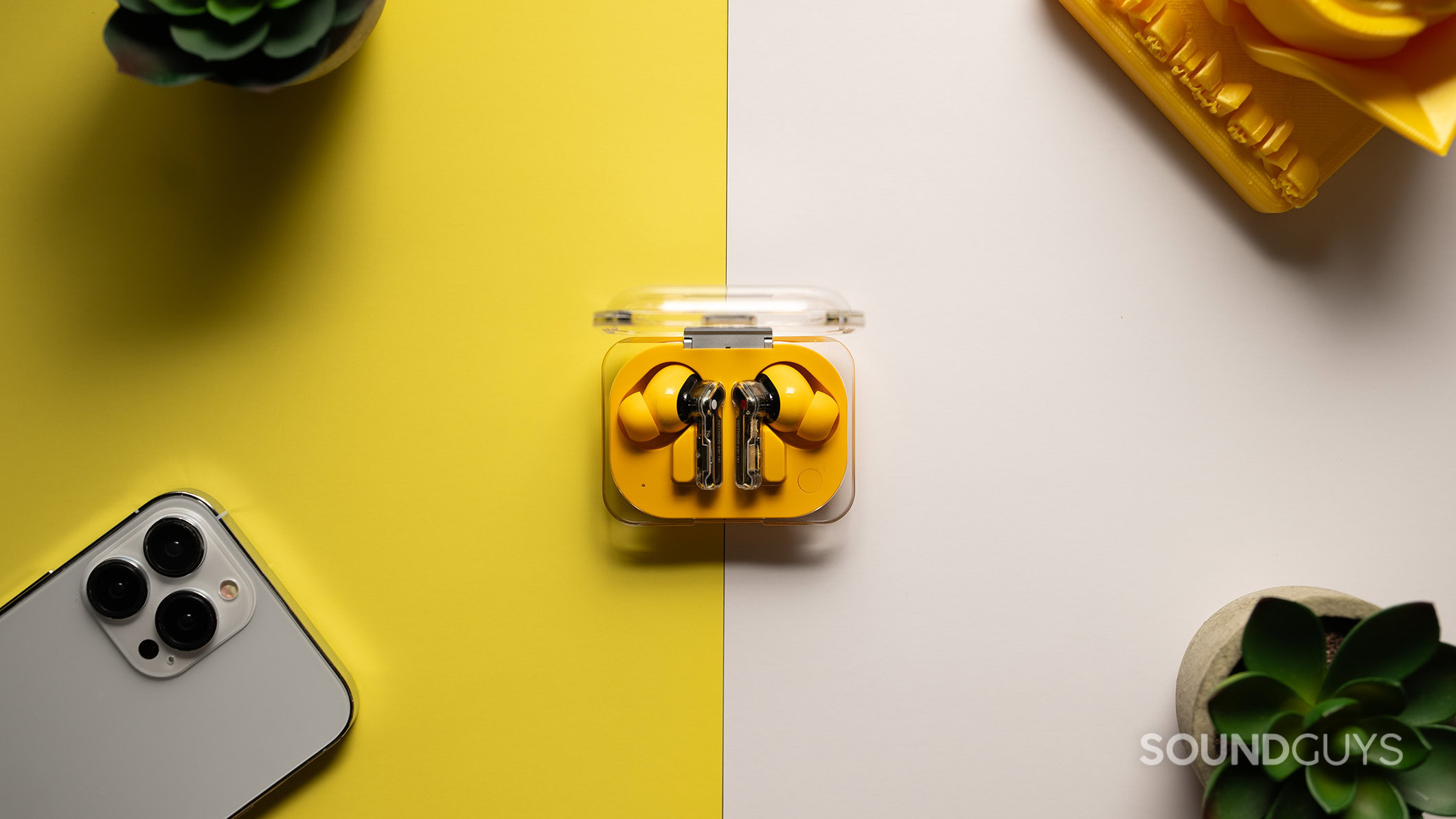
The Nothing Ear (a) is the lower-cost sibling of the Nothing Ear. The Ear (a) is still a good option for casual listeners but less so for those who care about having the best sound quality. You don’t get the ceramic diaphragm drivers, and you don’t get access to the Advanced Equalizer inside the companion app if you have the Nothing Ear (a). Everything else is pretty much the same, so if you don’t care about having the best sound quality, you should get the Nothing Ear (a).
What should you get instead of the Nothing Ear?
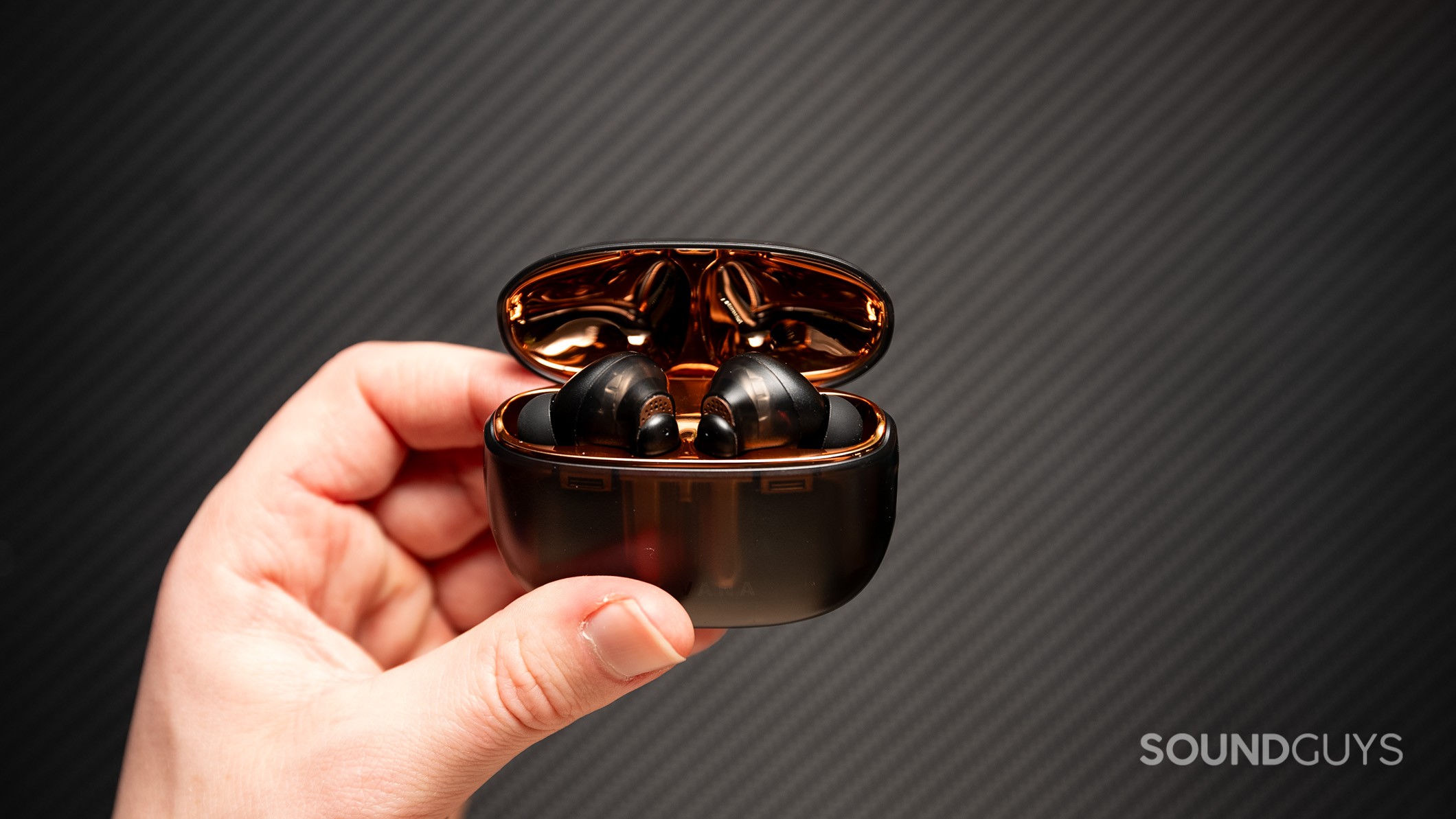
At this price point, there’s only one set of earbuds that can hold its own against the Nothing Ear — the Creative Aurvana Ace 2, $149.99 at Amazon. The Creative Aurvana Ace 2 also has exceptional sound quality thanks to its MEMS drivers and Snapdragon Sound with aptX Lossless support. On the other hand, the drawbacks of the Creative earbuds come in its app, battery life, and microphone quality.
If you own an iPhone and can afford it, you should consider the Apple AirPods Pro 2, $239 at Amazon. If you are just looking for earbuds for the gym, you should look at the Jabra Elite 8 Active, $199 at Amazon. To see your options, look through our list of the best wireless earbuds.
Frequently asked questions
The Nothing Ear is IP54 rated, which means it is water-resistant, but not water-proof. It can handle sweat and accidental water splashes, but you shouldn’t submerge the earbuds under water.
Yep, the Nothing Ear works with iPhone, although you can’t use LHDC or LDAC codecs with Apple devices. While you don’t get the same streaming quality that some Android users can enjoy, the Nothing Ear is still a great AirPods alternative for iPhone users.